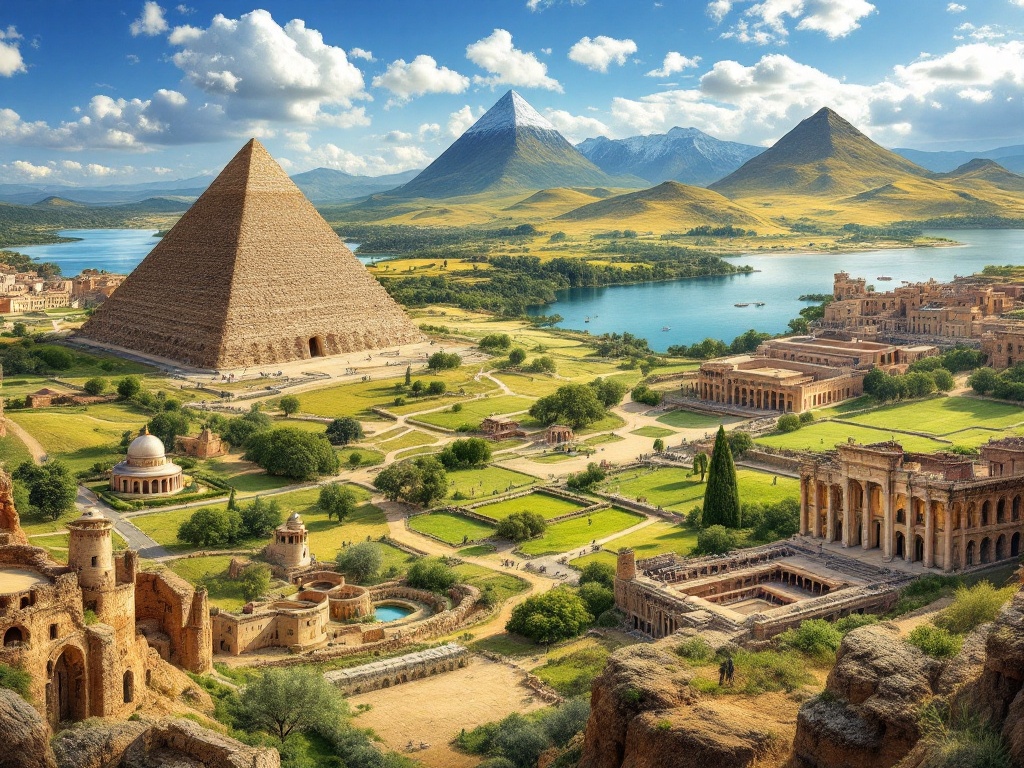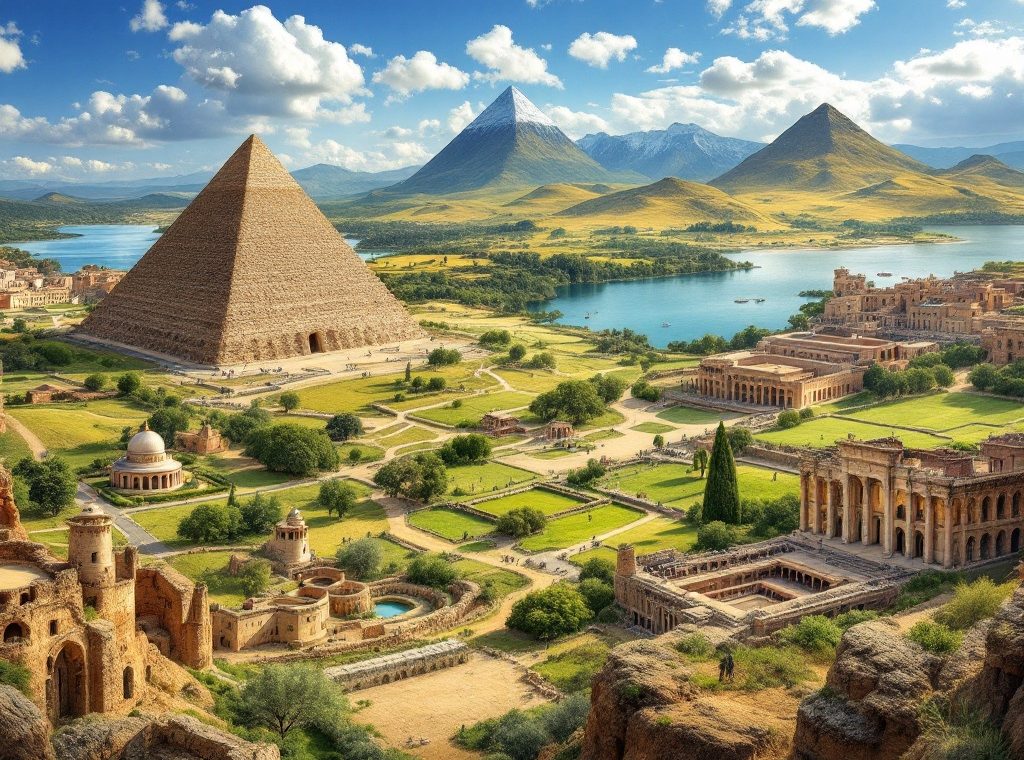Ancient Places Around the World That You Must Visit
Journey through time and discover the world’s most remarkable ancient places. From the Egyptian Pyramids of Giza to the enigmatic Stonehenge, explore architectural marvels and unlock the secrets of lost civilizations. Witness the grandeur of Rome’s Colosseum, the ingenuity of Machu Picchu, and the artistry of Petra. Uncover the mysteries of the Terracotta Army, the Taj Mahal’s timeless beauty, and the rock-hewn churches of Lalibela. Embark on an enriching adventure and connect with the past. Explore these wonders today!
Important information

- The Egyptian Pyramids of Giza are a testament to ancient engineering and one of the last remaining wonders of the ancient world.
- Machu Picchu, high in the Andes, reveals the Inca civilization’s ingenuity with its intricate dry-stone walls and agricultural terracing.
- Stonehenge in England is a prehistoric monument whose purpose and construction methods remain a mystery, possibly linked to astronomical events.
- Petra, Jordan, carved into sandstone cliffs, showcases the Nabataeans’ rock-cut architecture and ingenious water system.
- The Colosseum in Rome, Italy, is an iconic amphitheater and a symbol of Roman engineering and entertainment culture.
Remarkable Ancient Places Around the World That You Must Visit
The Egyptian Pyramids of Giza, showcasing incredible engineering feats, stand as a testament to ancient ingenuity.
Rome’s Colosseum embodies the grandeur of the Roman Empire, offering a glimpse into its rich history.
High in the Andes, Machu Picchu reveals the remarkable ingenuity of the Inca civilization.
Stonehenge, a prehistoric monument in England, continues to mystify and intrigue visitors with its enigmatic origins.
Carved into Jordan’s sandstone cliffs, Petra stands as a testament to the artistry of the Nabataean people.
These ancient wonders offer enriching experiences, connecting travelers and history buffs with the past. They foster appreciation for human creativity and deepen cultural understanding.
Ancient Wonders of Egypt
Egypt’s ancient wonders, such as the Giza Pyramids, Valley of the Kings, and Abu Simbel, offer a glimpse into a rich history and captivating culture. The massive Pyramids of Giza stand as testaments to Egyptian engineering. Within the Valley of the Kings lie the tombs of numerous pharaohs. The colossal statues of Abu Simbel further demonstrate impressive artistry, inspiring awe in all who visit.
Pyramids of Giza, Egypt
The Pyramids of Giza, constructed approximately 4,500 years ago, served as tombs for Egyptian pharaohs. This ancient complex stands as a testament to remarkable engineering and remains an iconic symbol of ancient Egypt. It is notably the last remaining wonder of the ancient world. The pyramids offer a glimpse into ancient Egyptian burial practices and beliefs surrounding the afterlife. The largest and oldest pyramid, the Great Pyramid, was built for Pharaoh Khufu. The presence of the Sphinx within the complex further amplifies its historical significance.
Valley of the Kings, Egypt
Egypt’s Valley of the Kings, a royal burial ground, houses 62 elaborate pharaoh tombs. Each tomb reveals ancient Egyptian burial rituals and offers a glimpse into their fascinating past.
Abu Simbel, Aswan, Egypt
Abu Simbel’s two magnificent temples, dedicated to Ramesses II, are among the world’s most breathtaking ancient monuments. They are a testament to ancient Egyptian ingenuity and artistic skill.
Architectural Marvels of Asia
Asia is home to a wealth of breathtaking architectural marvels. The Great Wall of China, a UNESCO World Heritage site, stands as a testament to human engineering. The Terracotta Army, silently guarding the tomb of China’s First Emperor, offers a poignant glimpse into the power and grandeur of ancient civilizations. India’s Taj Mahal, an ivory-white marble mausoleum, is a timeless embodiment of Mughal architectural elegance. The Ellora Caves, a complex of rock-cut temples showcasing Hindu, Buddhist, and Jain art, reflect India’s rich and diverse religious heritage. Cambodia’s Angkor Wat, a vast temple complex dedicated to Vishnu, stands as a masterpiece of Khmer artistry. Indonesia contributes Borobudur, a Mahayana Buddhist temple adorned with intricate carvings, and the Prambanan Temple Compounds, dedicated to the Trimurti and showcasing the heights of Hindu architecture. These sites represent just a fraction of Asia’s architectural treasures.
Great Wall of China
The Great Wall of China, stretching over 13,000 miles, stands as a massive testament to ancient Chinese engineering. Built over numerous dynasties, it protected China from invaders. Recognized for its global importance, the wall is a UNESCO World Heritage site. Its immense size continues to impress visitors from around the world, who come to experience this ancient wonder.
Terracotta Warriors, China
Near Xi’an, China, lies the awe-inspiring Terracotta Army. Thousands of life-sized terracotta figures—soldiers, horses, and chariots—stand in silent formation. Commissioned by Emperor Qin Shi Huang for his mausoleum, this incredible project began in the late third century BC. The figures showcase the Qin dynasty’s remarkable craftsmanship and offer a unique window into ancient Chinese military practices. They are a true wonder of the ancient world.
Taj Mahal, Agra, India
Located in Agra, India, the breathtaking Taj Mahal is a UNESCO World Heritage site embodying eternal love. Commissioned in the 17th century, its stunning architecture and intricate details make this monument one of the world’s most celebrated wonders.
Ellora Caves, India
India’s Ellora Caves, a UNESCO World Heritage Site, are renowned for their exceptional rock-cut architecture. Thirty-four caves, sculpted from solid basalt cliffs, present a unique fusion of three major religions: Buddhism, Hinduism, and Jainism. This remarkable site reflects ancient Indian artistry and signifies a deep sense of religious harmony. The caves feature intricate carvings, sculptures, and murals, showcasing the rich history and diverse cultural heritage of India.
Angkor Wat, Cambodia
Angkor Wat, located in Cambodia’s Angkor Archaeological Park, is the world’s largest religious monument. Originally constructed as a Hindu temple dedicated to Vishnu, it transitioned into a Buddhist temple. The temple’s intricate carvings and vast scale are a testament to the Khmer Empire’s exceptional artistry. This UNESCO World Heritage site stands as a powerful symbol of Cambodian culture.
Borobudur Temple, Indonesia
Borobudur Temple, a Mahayana Buddhist monument, stands in Magelang Regency, near Yogyakarta, on the Indonesian island of Java. Its three platforms symbolize the realms of Buddhist cosmology: Kamadhatu (desire), Rupadhatu (form), and Arupadhatu (formlessness).
Prambanan Temple Compounds, Indonesia
Indonesia’s Prambanan Temple Compounds, a stunning collection of 9th-century Hindu and Buddhist temples, boasts remarkable architecture and immense historical significance. It’s a truly unmissable destination for any visitor.
Iconic Ruins of Europe
Discover the magnificent Acropolis in Athens, Greece, and explore its iconic temples, including the renowned Parthenon.
Journey back in time at Olympia, Greece, the birthplace of the original Olympic Games.
Marvel at the impressive engineering of the Colosseum in Rome, a testament to Roman ingenuity.
Step into the past at Pompeii, Italy, and witness a preserved snapshot of Roman daily life.
Unravel the mysteries of Stonehenge in England, a prehistoric enigma that continues to captivate.
Acropolis, Greece
The Acropolis, an ancient citadel overlooking Athens, houses the ruins of remarkable buildings, most notably the Parthenon. These structures, historically and architecturally significant, embody the power of ancient Greece and symbolize Athenian democracy. Iconic landmarks such as the Parthenon, Erechtheion, and Propylaea attract visitors from around the globe, eager to explore this rich cultural heritage.
Olympia, Greece
Olympia, Greece, the birthplace of the Olympic Games, is a significant archaeological site and a major religious sanctuary dedicated to Zeus.
Colosseum, Italy
The Colosseum, a potent symbol of Rome, is an iconic amphitheater renowned for its impressive architecture and rich history. Constructed around 70-80 AD, this ancient arena hosted thrilling gladiatorial contests, public spectacles, and even animal hunts. Its enduring structure reveals much about Roman engineering and offers a glimpse into their entertainment culture, serving as a testament to their ingenuity.
Archaeological Areas of Pompeii, Italy
Pompeii, frozen in time by the eruption of Mount Vesuvius in 79 AD, offers a unique window into Roman life. Preserved buildings showcase remarkable Roman architecture, while intricate frescoes and numerous artifacts reveal details of a vibrant and sophisticated culture. The site provides invaluable insights into Pompeii’s social structure and thriving economy, illustrating the daily lives of its inhabitants, both in their homes and public spaces. Pompeii stands as an essential resource for understanding Roman urban planning, a truly remarkable archaeological treasure.
Stonehenge, England
Stonehenge, located in Wiltshire, England, is a prehistoric monument consisting of a ring of standing stones. Experts believe it was built around 2500 BC. The exact purpose and construction methods of this mysterious structure are still unknown. Theories about Stonehenge range from astronomical significance to religious or ceremonial uses. The stones’ alignment with the solstices suggests a solar connection, highlighting the remarkable engineering of this ancient marvel.
Fascinating Sites in the Middle East
Jordan’s Petra, a Nabataean city, is renowned for its breathtaking rock-cut architecture, most notably the Treasury.
Lebanon’s Baalbek Temple complex, dedicated to Roman deities like Jupiter, Bacchus, and Venus, is another marvel.
Hegra, Saudi Arabia’s southern Nabataean capital, also features remarkably preserved tombs, echoing Petra’s grandeur.
Petra, Jordan
Petra, Jordan, famed for its breathtaking rock-cut architecture, showcases the ingenuity of the Nabataeans. This ancient city, a UNESCO World Heritage site, also boasts a remarkable water system. Nestled among Jordan’s sandstone cliffs, Petra flourished as a vital trading center.
Baalbek Temple, Lebanon
Visit the UNESCO World Heritage site of Baalbek and witness the remarkably preserved Roman temples, some of the largest and best-preserved anywhere. Explore the Temples of Jupiter, Bacchus, and Venus, each offering an impressive glimpse into the grandeur of Roman architecture.
Hegra Archaeological Site, Saudi Arabia
Hegra, also known as Al-Hijr or Mada’in Salih, is a UNESCO World Heritage site located in Saudi Arabia’s AlUla region. This site features remarkably well-preserved tombs with elaborate facades carved directly into sandstone cliffs, dating from the 1st century BCE to the 1st century CE. These impressive monuments showcase the Nabataeans’ architectural prowess, echoing the style of Petra in Jordan, yet displaying distinctive regional variations.
Historic Treasures of the Americas
Perched high in the Peruvian Andes, Machu Picchu, a 15th-century Inca citadel, stands as a testament to ingenuity. Far older, however, is Peru’s City of Caral-Supe, a 5,000-year-old metropolis ranking among the Americas’ earliest urban centers.
In Mexico, the Mayan city of Chichen Itza boasts its iconic pyramid, El Castillo. Further south, Guatemala’s Tikal, another significant Mayan hub, reveals temples and palaces from the pre-classic period. Each of these ancient sites offers a unique window into remarkable bygone cultures.
Machu Picchu, Peru
Nestled high in the Peruvian Andes, Machu Picchu, a 15th-century Inca citadel, amazes visitors with its intricate dry-stone walls constructed entirely without mortar. This UNESCO World Heritage site, often referred to as the “Lost City of the Incas,” showcases impressive architecture and ingenious agricultural terracing.
City of Caral-Supe, Peru
Caral-Supe, Peru, dating back to 2600 BCE, stands as one of the oldest cities in the Americas, a testament to ancient ingenuity. This metropolis boasts impressive pyramids, expansive plazas, and residential areas. Archaeological discoveries at the site have unearthed numerous artifacts, offering valuable insights into the rise of complex societies in the early Americas.
Chichen Itza, Mexico
Located in Yucatán, Mexico, the UNESCO World Heritage site of Chichen Itza showcases the ancient Mayan civilization’s remarkable grasp of mathematics and astronomy. It stands as a true testament to their ingenuity.
Tikal, Guatemala
Deep within the Guatemalan rainforest, the ancient Mayan city of Tikal emerges, a sprawling archaeological site where impressive pyramids and temples pierce the jungle canopy. It’s a truly breathtaking spectacle.
Ancient Civilizations in Africa
Africa, the cradle of humankind, has witnessed the rise and fall of numerous ancient civilizations, leaving behind a legacy of remarkable monuments, cities, and artifacts. Great Zimbabwe’s imposing stone structures stand as a testament to a powerful kingdom that thrived between the 11th and 15th centuries. Carthage, established by the Phoenicians, emerged as a vital trading center in the ancient Mediterranean world. Ethiopia’s Lalibela, with its awe-inspiring rock-hewn churches, exemplifies the region’s profound religious heritage.
Great Zimbabwe, Zimbabwe
Great Zimbabwe, a ruined city in southeastern Zimbabwe, stands as a testament to a once-thriving kingdom. Constructed between the 11th and 15th centuries by ancestors of the Shona people, indigenous Bantu communities, the site is renowned for its remarkable architecture, especially the Great Enclosure. The enclosure’s massive circular wall and distinctive conical towers showcase impressive Late Iron Age engineering. Serving as the kingdom’s capital, Great Zimbabwe was mysteriously abandoned, leaving behind a rich legacy. The intricate dry-stone walls, built with precisely fitted granite blocks, highlight the builders’ exceptional skill. In recognition of its historical importance, UNESCO designated Great Zimbabwe a World Heritage Site in 1986, preserving this powerful symbol of Africa’s heritage.
Carthage, Tunisia
Carthage, Tunisia, a bustling trade center founded by the Phoenicians in 814 B.C.E., now offers visitors a captivating glimpse into ancient Mediterranean life. Exploring its ruins reveals remnants of a once-great city, showcasing its vibrant commerce and rich culture.
Lalibela, Ethiopia
Lalibela, Ethiopia is renowned for its rock-hewn churches. Carved entirely from bedrock, these monolithic structures are a testament to human ingenuity and artistry. This extraordinary UNESCO World Heritage site remains an important pilgrimage destination for followers of the Ethiopian Orthodox Tewahedo faith.
Unique Cultural Heritage Sites
Ireland’s Newgrange is a prehistoric marvel, a massive circular mound containing a passage tomb dating back to the Neolithic period. It offers a fascinating glimpse into the ingenuity of ancient civilizations.
Turkey’s Cappadocia region boasts the incredible underground city of Derinkuyu. Carved into soft volcanic rock, it once sheltered thousands seeking refuge from war and persecution. This site also offers a fascinating glimpse into the ingenuity of ancient civilizations.
Newgrange, Ireland
Dating back to 3200 BC, Newgrange is a massive Neolithic passage tomb in Ireland’s County Meath. It predates both Stonehenge and the Egyptian pyramids. This remarkable site is renowned for its unique winter solstice alignment. For 17 minutes at dawn, a beam of light illuminates the passage and chamber within. This phenomenon demonstrates the Neolithic people’s sophisticated understanding of astronomy and their profound connection to the celestial cycles. Newgrange stands as a crucial example of prehistoric architecture, offering valuable insights into the beliefs and practices of this ancient culture. It is a testament to their ingenuity and worldview.
Derinkuyu Underground City, Turkey
Derinkuyu, an incredible underground city in Cappadocia, Turkey, descends many levels, providing a safe haven from invaders. This engineering marvel showcases the builders’ ingenuity with its complex network of tunnels and rooms. Ancient inhabitants carved living spaces, ventilation shafts, and wells, creating a self-sufficient world. Wineries, stables, and chapels further demonstrate the city’s complexity and the resourcefulness of those who sought refuge within its depths. Derinkuyu stands as a testament to their creativity in the face of danger. Discover the wonders of Derinkuyu:
- Multi-level city: providing refuge from invaders.
- Engineering marvel: a complex network of tunnels and rooms.
- Self-sufficient world: featuring living spaces, ventilation, and wells.
- Diverse facilities: including wineries, stables, and chapels.
- A testament to ingenuity: showcasing resourcefulness and creativity.
Ancient Landmarks of the Pacific
The Pacific Ocean is home to ancient wonders, like the imposing Moai statues of Rapa Nui (Easter Island), Chile. These figures, carved from volcanic rock, represent ancestors and deities. Ancient wonders are also found in other parts of the world. Scotland’s Heart of Neolithic Orkney features a large chambered tomb and several stone circles, offering a glimpse into Neolithic life.
Moai, Easter Island
Easter Island, or Rapa Nui, is famous for its iconic Moai, monolithic statues carved from volcanic rock. These impressive figures, nearly 900 in number, represent deified ancestors and vary considerably in size. Imagine these massive stone faces gazing across the island—a truly remarkable spectacle.
Rapa Nui, Chile
Easter Island, also known as Rapa Nui, is a Chilean island in the southeastern Pacific Ocean, famed for its nearly 1,000 moai. These massive statues, carved from volcanic rock by the early Rapa Nui people, powerfully symbolize the island’s unique Polynesian heritage. Beyond the moai, explore other sites like Ahu Tongariki, Rano Raraku, and Orongo for deeper insights into this fascinating ancient civilization. Ahu Tongariki is the largest ahu, a ceremonial platform, on the island, boasting 15 restored moai. Rano Raraku is the volcanic crater where most of the moai were quarried, offering a glimpse into the creation process. Orongo, a ceremonial village, provides breathtaking views and insights into the intriguing birdman cult.
Heart of Neolithic Orkney, Scotland
Orkney, Scotland, is home to the “Heart of Neolithic Orkney,” a UNESCO World Heritage site. This area boasts remarkable Neolithic monuments that offer a captivating glimpse into life millennia ago. Explore the exceptionally preserved village of Skara Brae, marvel at the imposing Ring of Brodgar, and contemplate the Standing Stones of Stenness. Don’t miss Maeshowe, a significant chambered cairn. These structures together paint a vivid picture of Neolithic life in Scotland.














